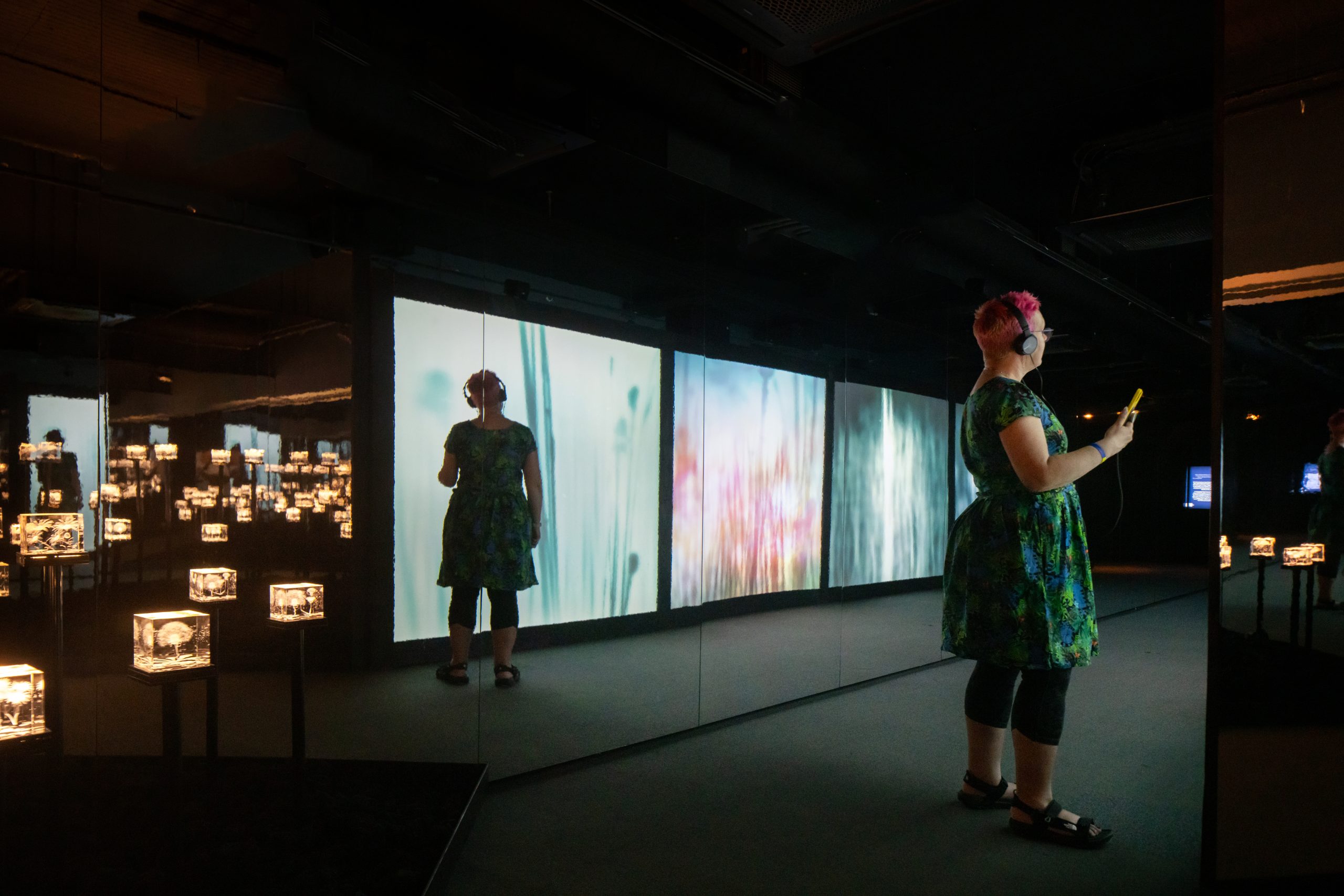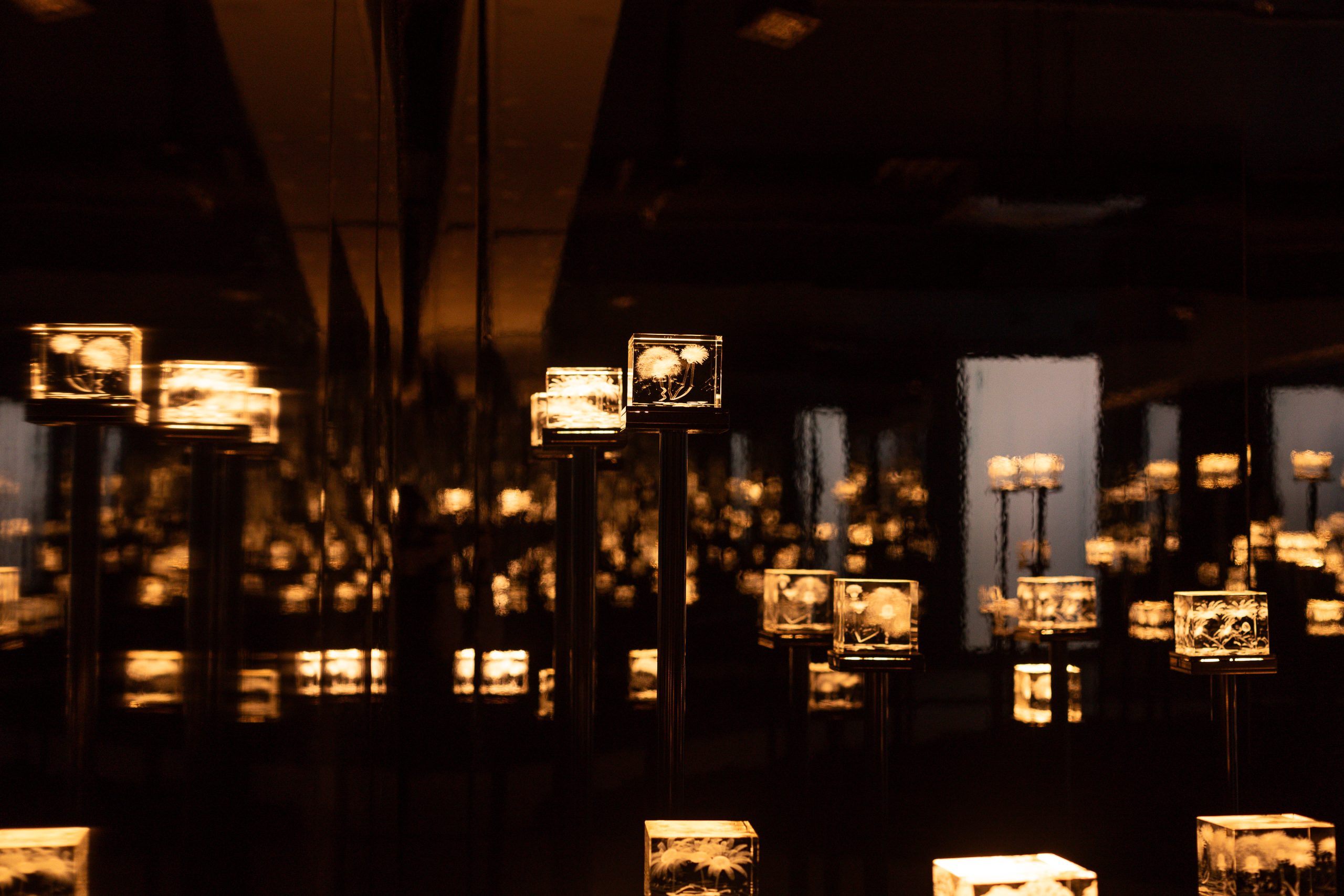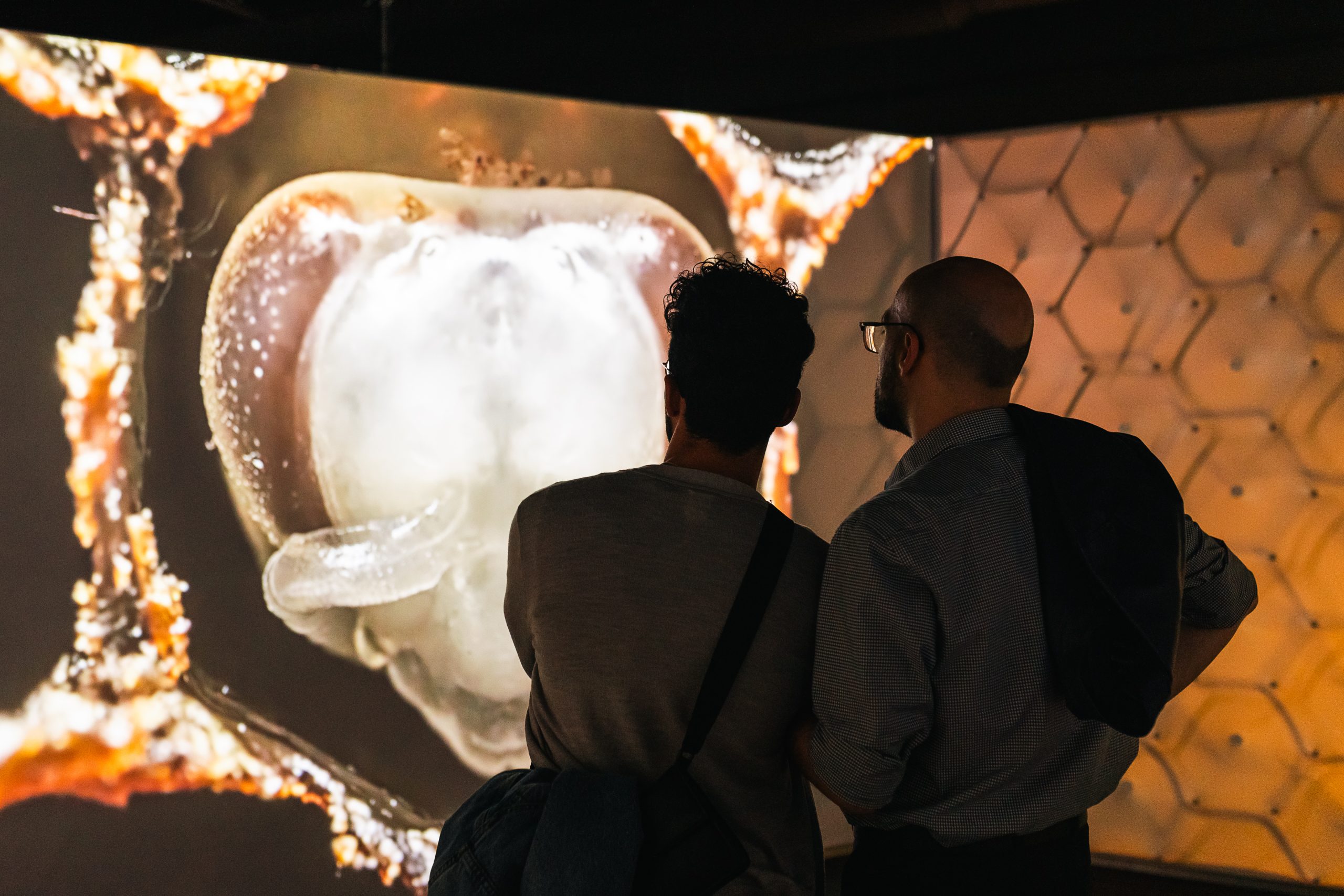“It is an astonishment to be alive and it behoves you to be astonished”
– John Donne, Poet, 1572-1631.
This is a huge exhibition devoted to a tiny creature without which life, as we know it, could not exist. What has been created at the World Museum with “Bees: A Story of Survival” is such an extraordinary fusion of art, science, music and architecture, that the word ‘exhibition’ gives no clue as to the complete sensory experience that awaits visitors.

Bees: A Story of Survival takes visitors into a hive to find out the life of the bee, 2024 (Photo credit: © Robin Clewley photography)
The artist behind it is Wolfgang Buttress who has previously displayed his passion for bees with works such as ‘The Hive’ in 2015 at the Botanic Gardens in Kew and ‘Beam’ at Glastonbury in 2019. This time, through his partnership with the Museum, he is harnessing technology to stimulate all the senses: “It’s not just what you see, it’s what you hear, it’s what you can touch, it’s what you can smell and you’ll feel how bees communicate with each other through vibration”.
It’s quite a journey through all the eight rooms of the exhibition, one that provoked in me a range of emotions – from sadness at how bees are struggling, to total wonder at their ingenuity and finally, to hope, that it is not too late to save them. Of these, it is hope that Buttress wants us to hold onto: “We have this capacity for love, for empathy, for change and for making things better if we want to. And so for me that was important, that there is a sense of beauty, a sense of harmony, a sense of wonder, a sense of delight and you don’t leave the exhibition feeling hopeless”.
He is absolutely right, that without elements of play in the exhibition, we could be left feeling guilty and defeated when confronted with the peril bees are facing. The exhibition has avoided being preachy but has not glossed over the problems we have caused, as Buttress emphasises: “If we weren’t around the bees would be doing absolutely fine, so it’s us that’s the problem. Bees can be seen as sentinels of the earth. Their health and wellbeing mirror the health of the Earth and they are dying in unprecedented numbers. Their existential challenges reflect our own – they die and suffer, we die and suffer”.
With this in mind, one of the most affecting rooms for me was ‘Vanishing’, where Buttress imagined a world without bees and other insects – one without sound, colour or movement. He has partly achieved this by changing the soundscape, so that you feel a shift in mood. The audio guide tells us how “the musicians have deliberately changed from a major to a minor key, sucking the life out of the melody and rhythm”.

Bees exhibition, 2024 (Photo credit: ©Mark Hadden photography)
This is just one of the unique compositions that Buttress and his band, The Karman Line Collective, have created for the accompanying soundscape in each of the rooms. They’ve used high quality field recordings of bee colonies and processed this raw sound in combination with instruments such as the cello, trumpet and the human voice. There is an encyclopaedic number of fascinating facts related to this exhibition but one I particularly love is that the cello sounds used in the soundscape were recorded inside the first Bramley apple tree ever planted – serendipitously located near Buttress’s studio in Nottinghamshire. It is nearing the end of its life and so its use was a symbolic way of highlighting the plight of bees.
The music in each of the rooms has a specific purpose, not least to show how music – or, rather, sound – is crucial to bees. This might seem surprising given that they don’t have ears, but their ‘hearing’, as Buttress mentioned earlier, is through vibration, in the same way as a profoundly deaf person can enjoy music. It was extraordinary to feel the vibration through my feet (via subwoofers secreted in the floor!) from a live stream coming right from the heart of a nearby colony. The activity in the hive is constantly changing so the vibration will be different for everyone. The scientific collaborator on the project was Professor Martin Bencsik, one of the first people to capture the sounds and waveforms of a honeybee swarm leaving the nest – which Buttress describes as sounding “propulsive and purposeful rather than chaotic”.

Bees: A Story of Survival, 2024, Visitors can explore Wolfgang Buttress’ stunning interpretation of a wildflower meadow (Photo credit: © Robin Clewley photography)
The hexagonal space towards the end of the exhibition is great fun. Stepping into it allows your form – in any pose – to be captured on camera, reinterpreted and represented as a silhouette of particles and stardust in the atmosphere. Just outside this area is a stunning display of particles – individual, illuminated, highly magnified pollen grains etched into crystal glass. Working with scientist, Dr. Oliver Wilson, Buttress explains that this presentation was “a way of making the invisible visible”. These beautiful complex structures surely will enchant even hay-fever sufferers.
The meadow room was another of my favourites and features more illuminated crystal glass blocks. This time they contain etched flowers that are particularly suited to the feeding habits of different bees. Who knew that bees are able to see ultraviolet light and that flowers have evolved to know this and taken advantage of it by developing patterns to show pollinators the best places to land for nectar? I certainly didn’t. It’s an amazing example of connectivity in nature.
The exhibition has involved making use of the World Museum’s nationally and internationally important entomology collection and specialist curators. I spoke to Leanna Dixon, an Assistant Entomologist at the Museum and part of Tanyptera, a Trust that promotes the study and conservation of invertebrates in North West England. She explained that the Sefton coast is one of the best areas for a diversity of invertebrates that we have in the UK: “There are a few different bees that nest in the dunes themselves. They’re not like honey bees or bumble bees that live in a social hive – perhaps 90% of our bees are solitary so the female will perhaps nest in the ground or in sand dunes or in leaf stems or in wood”. Near the end of the “Be” room, you can peek through holes and catch a glimpse of some of these species as they drift across the walls and investigate their unique nesting habits.
It is easy to feel chastened by how little one knows about something as commonplace as a bee but there is nothing didactic about this exhibition.
The aim was to be as far as you can imagine from endless texts and objects in boxes and the now ubiquitous QR codes play their part in this in each room. For once I was pleased to see them because they have eliminated the need for turgid, explanatory wall notes. The codes also link to excellent audio guides and transcripts of the commentary.

Bees: A Story of Survival, 2024 (Photo credit: ©Robin Clewley photography)
There’s a fundamental idea at the core of the exhibition – that of demonstrating the really severe existential challenge for bees. But as Buttress stresses, it was important to show that we still have the ability, if we choose, to turn it around: “And that’s why the last two spaces were intentionally, I wouldn’t say more optimistic, but have the sense of opportunity. The biggest thing we can do is just plant more re-wild stuff, to do that personal thing, maybe join pressure groups to pressurise local, national and international governments just to do better”.
Many organisations such as the Bumblebee Conservation Trust are working to protect the habitats and food sources of bees. They raise awareness of the importance of the solitary bee species and put pressure on governments to make meaningful policy changes to safeguard the future of our ecosystems. In Liverpool, groups like Scouse Flowerhouse are promoting the message of a flower city, a space in which bees and people can live and thrive together. There are also citizen science initiatives such as iNaturalist and iRecord where you can assist with the monitoring and analysis of insect populations.
But the single most important thing we as individuals can do, is to provide habitat and things for the bees to feed on and nest. So things like letting your grass grow longer (yeah!), letting the dandelions and buttercups flower – even just having a little window box with bee-friendly flowers – these are simple acts with a big impact.
A final thought from the artist: “What bees really taught me is a sense of humility, that we’re not the centre of the universe. I want the audience to feel empathy as well as an understanding and appreciation of these incredible creatures. If we love and respect bees a little bit more after seeing this exhibition, then we may well make the earth a better place for them and us to live in.”
***
“Bees: A Story of Survival at World Museum“, part of National Museums Liverpool, runs until Saturday 5 May 2025.
Tickets: Adults: £12. Free for children under 11. Concessions available.
Filed under: Art & Photography
Tagged with: art, artist, audio, bees, ecosystems, exhibition, innovation, liverpool, Nature, sculpture, survival, technology, wolfgang buttress, world, world museum



Comments